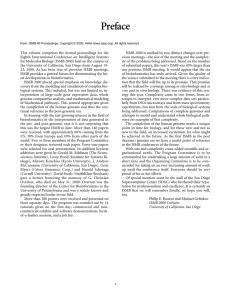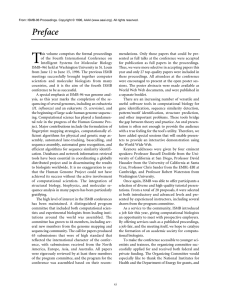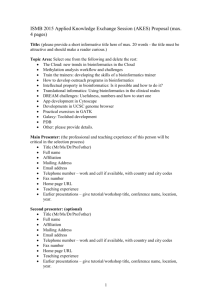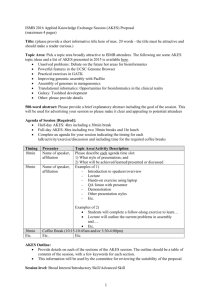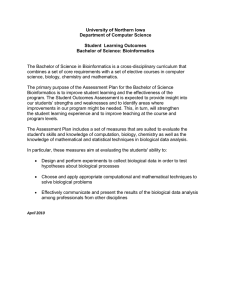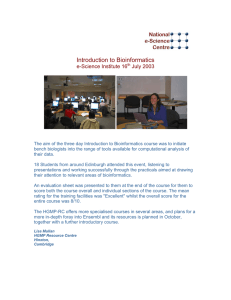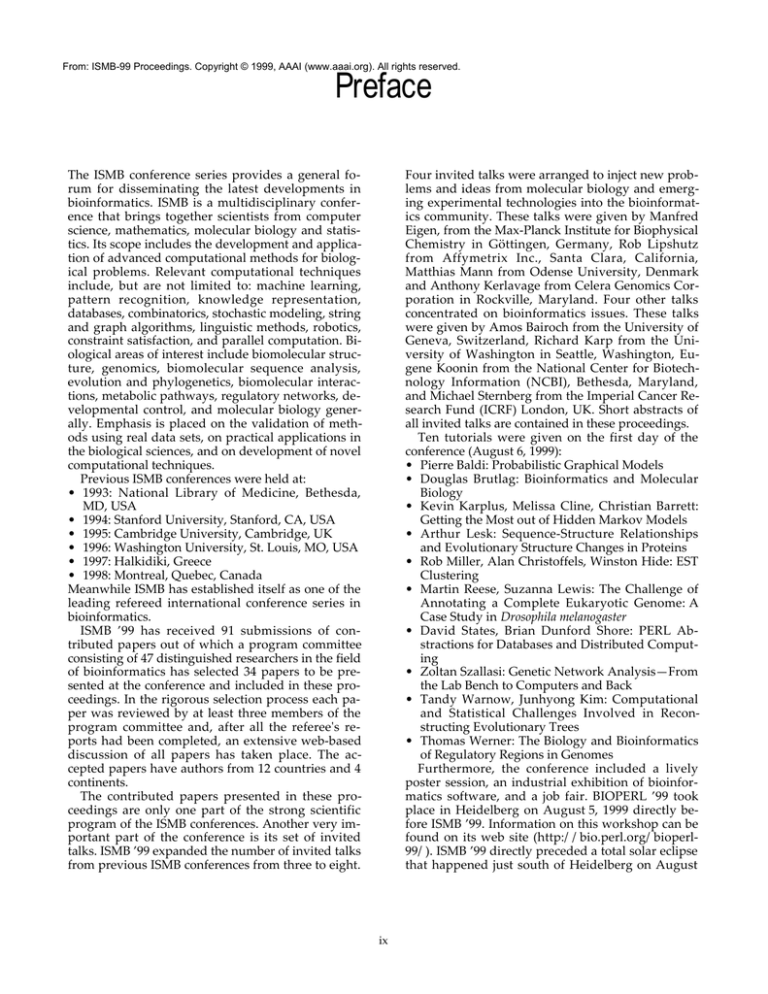
From: ISMB-99 Proceedings. Copyright © 1999, AAAI (www.aaai.org). All rights reserved.
Preface
The ISMB conference series provides a general forum for disseminating the latest developments in
bioinformatics. ISMB is a multidisciplinary conference that brings together scientists from computer
science, mathematics, molecular biology and statistics. Its scope includes the development and application of advanced computational methods for biological problems. Relevant computational techniques
include, but are not limited to: machine learning,
pattern recognition, knowledge representation,
databases, combinatorics, stochastic modeling, string
and graph algorithms, linguistic methods, robotics,
constraint satisfaction, and parallel computation. Biological areas of interest include biomolecular structure, genomics, biomolecular sequence analysis,
evolution and phylogenetics, biomolecular interactions, metabolic pathways, regulatory networks, developmental control, and molecular biology generally. Emphasis is placed on the validation of methods using real data sets, on practical applications in
the biological sciences, and on development of novel
computational techniques.
Previous ISMB conferences were held at:
• 1993: National Library of Medicine, Bethesda,
MD, USA
• 1994: Stanford University, Stanford, CA, USA
• 1995: Cambridge University, Cambridge, UK
• 1996: Washington University, St. Louis, MO, USA
• 1997: Halkidiki, Greece
• 1998: Montreal, Quebec, Canada
Meanwhile ISMB has established itself as one of the
leading refereed international conference series in
bioinformatics.
ISMB ’99 has received 91 submissions of contributed papers out of which a program committee
consisting of 47 distinguished researchers in the field
of bioinformatics has selected 34 papers to be presented at the conference and included in these proceedings. In the rigorous selection process each paper was reviewed by at least three members of the
program committee and, after all the referee's reports had been completed, an extensive web-based
discussion of all papers has taken place. The accepted papers have authors from 12 countries and 4
continents.
The contributed papers presented in these proceedings are only one part of the strong scientific
program of the ISMB conferences. Another very important part of the conference is its set of invited
talks. ISMB ’99 expanded the number of invited talks
from previous ISMB conferences from three to eight.
Four invited talks were arranged to inject new problems and ideas from molecular biology and emerging experimental technologies into the bioinformatics community. These talks were given by Manfred
Eigen, from the Max-Planck Institute for Biophysical
Chemistry in Göttingen, Germany, Rob Lipshutz
from Affymetrix Inc., Santa Clara, California,
Matthias Mann from Odense University, Denmark
and Anthony Kerlavage from Celera Genomics Corporation in Rockville, Maryland. Four other talks
concentrated on bioinformatics issues. These talks
were given by Amos Bairoch from the University of
Geneva, Switzerland, Richard Karp from the University of Washington in Seattle, Washington, Eugene Koonin from the National Center for Biotechnology Information (NCBI), Bethesda, Maryland,
and Michael Sternberg from the Imperial Cancer Research Fund (ICRF) London, UK. Short abstracts of
all invited talks are contained in these proceedings.
Ten tutorials were given on the first day of the
conference (August 6, 1999):
• Pierre Baldi: Probabilistic Graphical Models
• Douglas Brutlag: Bioinformatics and Molecular
Biology
• Kevin Karplus, Melissa Cline, Christian Barrett:
Getting the Most out of Hidden Markov Models
• Arthur Lesk: Sequence-Structure Relationships
and Evolutionary Structure Changes in Proteins
• Rob Miller, Alan Christoffels, Winston Hide: EST
Clustering
• Martin Reese, Suzanna Lewis: The Challenge of
Annotating a Complete Eukaryotic Genome: A
Case Study in Drosophila melanogaster
• David States, Brian Dunford Shore: PERL Abstractions for Databases and Distributed Computing
• Zoltan Szallasi: Genetic Network Analysis—From
the Lab Bench to Computers and Back
• Tandy Warnow, Junhyong Kim: Computational
and Statistical Challenges Involved in Reconstructing Evolutionary Trees
• Thomas Werner: The Biology and Bioinformatics
of Regulatory Regions in Genomes
Furthermore, the conference included a lively
poster session, an industrial exhibition of bioinformatics software, and a job fair. BIOPERL ’99 took
place in Heidelberg on August 5, 1999 directly before ISMB ’99. Information on this workshop can be
found on its web site (http://bio.perl.org/bioperl99/). ISMB ’99 directly preceded a total solar eclipse
that happened just south of Heidelberg on August
ix
11, 1999. The web site detailing all parts of the conference program can be found at its web site
(http://ismb99.gmd.de).
ISMB ’99 has been organized by the International
Society for Computational Biology (ISCB). The mission of this society is the advancement of the scientific understanding of living systems through computation; its emphasis is on the role of computing
and informatics in advancing molecular biology.
Information on ISCB can be found at its web site
(http://www.iscb.org). The conference was held in
cooperation with the American Association for Artificial Intelligence (AAAI).
It is a pleasure for the organizers to acknowledge
the sponsorship of the conference by the following
scientific societies: Deutsche Gesellschaft für
Chemisches Apparatewesen, Chemische Technik
und Biotechnologie e.V. (Dechema) and Gesellschaft
für Informatik e.V. (GI). Industrial sponsors of the
conference that had committed at the time that these
proceedings were going to print are Bayer AG,
Pharma Research, Wuppertal, Germany; Biomax Informatics GmbH, München, Germany; Byk Gulden,
Konstanz, Germany; European Media Laboratory
GmbH, Heidelberg, Germany; Merck KGaA, Darmstadt, Germany; Silicon Graphics Inc., SmithKline
Beecham Pharmaceuticals, USA and UK; SUN Microsystems, and TRIPOS Inc. Additional sponsors
are mentioned on the ISMB ’99 web site. LION bioscience AG, Heidelberg, Germany and GMD—German National Research Center for Information
Technology GmbH, Sankt Augustin, Germany, provided generous funding and general support for the
preparation and organization of ISMB ’99.
The planning and organization of a conference
such as ISMB ’99 with the commitment to publishing
a high quality refereed proceedings in a short time
frame relies extensively on the enthusiasm and
commitment of the program committee. The organizing committee wishes to formally express their
gratitude to all members of the program committee.
In conclusion the organizing committee would
like to thank Ms. Ingeborg Fatscher in Heidelberg
for her exceptional engagement in all on-location aspects of the conference preparation. Thanks go also
to Hannelore Napieraj at GMD, for secretarial help,
Ingrid Filter and Theo Mevissen at GMD for help
with the web presentation of the conference, Ulrich
Müller, Katharina Rusch, and Karina Schygulla at
LION bioscience AG for graphics design, and Mike
Hamilton at AAAI Press for once again producing a
proceedings of excellent quality.
Thomas Lengauer
Reinhard Schneider
Peer Bork
Douglas Brutlag
Janice Glasgow
Hans -Werner Mewes
Ralf Zimmer
ISMB ’99 Organizing Committee
x


